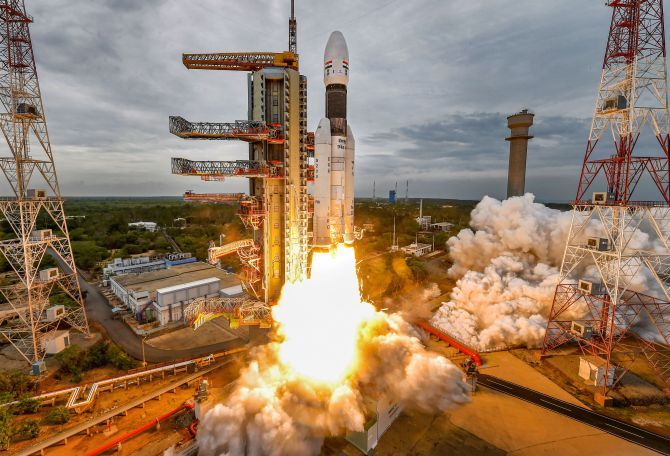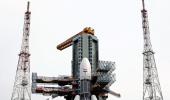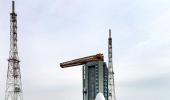The Chandrayaan-2 spacecraft is expected to reach the moon's orbit on August 20 and land on lunar surface on September 7.

Three weeks after its launch, India's Chandrayaan-2 left the earth's orbit and started moving towards the Moon after a crucial manoeuvre carried out by Indian Space Research Organisation scientists in the dark hours of Wednesday.
The spacecraft, now on 'Lunar Transfer Trajectory', is expected to reach the moon's orbit on August 20 with the soft landing of rover on the lunar surface planned on September 7.
The Bengaluru-headquartered Indian Space Research Organisation (ISRO) said it carried out the Trans Lunar Insertion (TLI) manoeuvre at 02:21 am IST as planned, following which the Chandrayaan-2 has successfully entered the 'Lunar Transfer Trajectory'.
'Today (August 14, 2019) after the Trans Lunar Insertion (TLI) manoeuvre operation, #Chandrayaan2 will depart from Earth's orbit and move towards the Moon,' ISRO tweeted along with a photo of its Chairman K Sivan and other top officials at the Control Centre in ISRO Telemetry Tracking and Command Network (ISTRAC) in Bengaluru.
During the orbit raising manoeuvre on Wednesday, the spacecraft's liquid engine was fired for about 1,203 seconds.
'With this, Chandrayaan-2 entered the Lunar Transfer Trajectory,' ISRO said in an update about the mission.
The health of the spacecraft is being 'continuously monitored' from the Mission Operations Complex (MOX) at ISTRAC with support from Indian Deep Space Network (IDSN) antennas at Byalalu, near Bengaluru, it said, adding, 'Since its launch on July 22 all systems onboard Chandrayaan-2 spacecraft are performing normal.'
In the most complex mission ever taken up by ISRO, the agency had launched India's second moon mission Chandrayaan-2 in earth orbit on July 22, aimed at landing a rover on the unexplored Lunar south pole.
The mission, if successful, will also make India the fourth country after Russia, the US and China to pull off a soft landing on the moon.
Earlier, the spacecraft's orbit was progressively increased five times during July 23 to August 6, by performing earth-bound orbit raising manoeuvres, aimed at placing it in the Lunar Transfer Trajectory.
The fifth earth-bound orbit raising manoeuvre for Chandryaan-2 spacecraft was performed successfully on August 6 using the onboard propulsion system for a firing duration of 1,041 seconds.
Chandrayaan-2, a three-component module comprising an orbiter, lander and rover, will approach Moon on August 20 and the spacecraft's liquid engine will be fired again to insert the spacecraft into a lunar orbit, ISRO said.
Following this, there will be further four orbit manoeuvres to make the spacecraft enter into its final orbit passing over the lunar poles at a distance of about 100 km
from the Moon's surface.
Four four orbit manoeuvres will be tentatively performed on August 21, 28, 30 and September 1.
Subsequently, Vikram lander will separate from the orbiter on September 2, and two orbit manoeuvres will be performed on the lander before the initiation of powered descent to make a soft landing on the lunar surface.
India's Geosynchronous Satellite Launch Vehicle, GSLV MkIII-M1, had successfully launched the 3,840-kg Chandrayaan-2 spacecraft into the earth's orbit on July 22.
Following the landing, the rover 'Pragyan' will roll out from lander 'Vikram' and carry out experiments on the lunar surface for a period of one lunar day, which is equal to 14 earth days.
The mission life of the lander is also one lunar day, while the orbiter will continue its mission for a year.
The orbiter carries eight scientific payloads for mapping the lunar surface and study the exosphere (outer atmosphere) of the Moon while the lander carries three scientific payloads to conduct surface and subsurface science experiments.
The rover carries two payloads to enhance the understanding of the lunar surface.
A passive experiment from US space agency National Aeronautics and Space Aadministration will also be carried onboard Chandrayaan-2, ISRO has said.
According to the ISRO, the mission objective of Chandrayaan-2 is to develop and demonstrate the key technologies for end-to-end lunar mission capability, including soft-landing and roving on the lunar surface.
On the science front, this mission aims to further expand the knowledge about the moon through a detailed study of its topography, mineralogy, surface chemical composition, thermo-physical characteristics and atmosphere, leading to a better understanding of the origin and evolution of the moon, the space agency had said.










